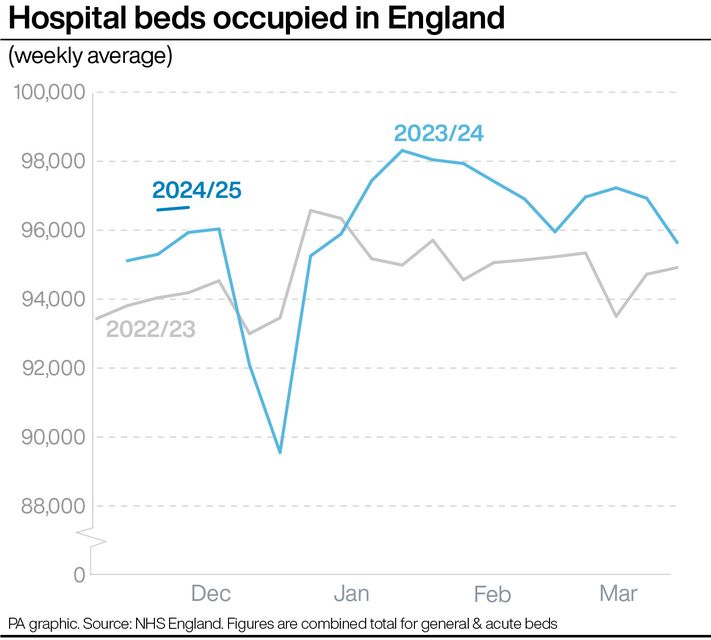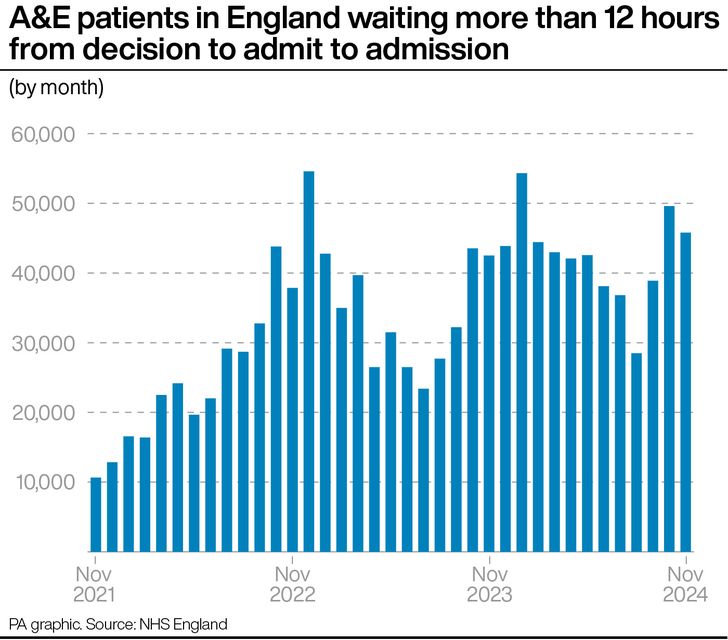Leading emergency doctors have expressed concern about a new guide on how to treat patients in corridors, saying it is “normalising the dangerous”.
NHS England has produced guidance on “providing safe and good quality care in temporary escalation spaces”.
But the Royal College of Emergency Medicine (RCEM) said the “nonsensical” guidance is “out of touch”.
The guidance, published in September, acknowledges corridor care is “not acceptable and should not be considered as standard” but due to current pressures some hospitals are “using temporary escalation spaces more regularly – and this use is no longer ‘in extremis’”.
It suggests how staff can deliver the “safest, most effective and highest quality care possible” to patients in these circumstances.
Responding, RCEM said it is “not possible to provide safe and good quality care” in corridors or cupboards.
In a position statement released to the PA news agency, the College said: “Advice from arm’s length bodies that appear out of touch with what is happening in our departments was always going to be poorly received.”
Use of corridors will lead to long waits in emergency departments which is “associated with measurable harm to patients”, it added.
The RCEM said patient privacy and dignity are “not maintained” when they are being cared for in corridors.
(PA Graphics)
Rest and sleep for patients is “difficult, if not impossible” and patient confidentiality “cannot be maintained”.
Meanwhile, controlling the spread of infection “is not possible” and it is “challenging” for staff to monitor patients.
Giving patients the treatment they need is “made more difficult and often delayed”, the College added.
“It is distressing for patients, particularly the old and the vulnerable, to be in open, noisy, brightly lit, often cold areas,” the RCEM position statement adds.
These points are “not consistent with good quality care” and “render many of the statements within the document nonsensical”, the College added.
(PA Graphics)
College president Dr Adrian Boyle, who penned the position statement along with vice-president Dr Ian Higginson, said: “While we understand why this guidance has been issued, as a College we are concerned that it represents a normalisation of what is an unacceptable and dangerous situation.
“It is not possible to provide truly safe care in environments such as corridors and cupboards.
“It also evidenced a lack of understanding for what has been happening in emergency departments for years.
“So-called ‘corridor care’ is a result of overcrowding, which leads to extended A&E stays that we know contribute to avoidable death.
“We and our members cannot, and will not, accept this situation.
We need your consent to load this Social Media content. We use a number of different Social Media outlets to manage extra content that can set cookies on your device and collect data about your activity.
“Rather than advising how to deal with overcrowding, all effort should be focused on preventing it.”
Professor Nicola Ranger, chief executive and general secretary at the Royal College of Nursing, said: “Care delivered in corridors and other non-clinical spaces is unsafe, undignified and unacceptable.
“It violates the privacy of patients and leaves staff without access to essential, life-saving equipment.
“There are no circumstances under which it constitutes good, safe care.
“What once used to be an exceptional circumstance, is now happening regularly in our hospitals.
“Health leaders and the secretary of state must waste no time in eradicating this shocking practice in the interests of patients and staff.”
Senior midwife Donna Ockenden, who has led reviews into patient safety in the NHS, said recently she felt corridor care had become “normalised” after seeing laminated signs on walls signposting where patients wait on trolleys.
In an interview with PA in October speaking about her daughter’s emergency treatment at an unnamed hospital, she said: “Trolley waits, corridor care, has become normalised.
“There are even signs on the wall now with numbers showing how many trolleys they can have any one time.
“There’s one particular corridor in this A&E where there’s space for five trolleys, and literally the walls are numbered with laminated signs.”
The news comes as some health commentators warned hospitals are running “red hot”, with some predicting winter could be “one of the worst the NHS has faced”.
Health Secretary Wes Streeting and NHS England boss Amanda Pritchard have told health leaders to prioritise patient safety this winter (Ben Whitley/PA)
The latest figures show an average of 96,661 beds were filled each day last week, 94.6% of the total available.
Health Secretary Wes Streeting has recently ordered health service leaders to “prioritise patient safety” as winter approaches.
Amanda Pritchard, chief executive of the NHS in England, has said “patient safety must be paramount”.
An NHS England spokesperson said: “As the document – developed with nurses and clinical leaders – makes clear, NHS England believes that caring for patients in temporary spaces is not acceptable, should never be considered as standard, and should only ever be used when all other options have been exhausted.
“Patient flow through hospitals and capacity in A&E has been impacted by record levels of demand going into winter, a jump in patients hospitalised with viruses like flu and norovirus, and thousands of beds taken up by patients ready for discharge.
“NHS staff are working hard to provide the safest possible care for patients this winter, including better use of live data, an expansion of same day emergency care, and more care in the community.”


